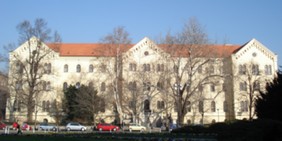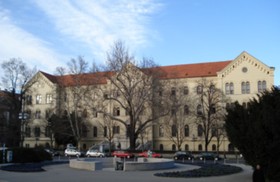University of Zagreb
A Short History of the University
© by Darko Zubrinic, Zagreb (1995)The first university institution in Croatia was founded by the Dominicans in Zadar in 1396 as the 'studium generale' for theology. Its international character can be seen from the fact that one of its first students had been fra Bonaventura of Ferrara (enrolled in 1396). In its earliest period it had twenty students from Italy, two from Poland and one from Germany. This institution had the privilege of conferring doctorates of theology. It existed until 1806, when it was canceled during the French (Napoleon's) occupation. Unfortunately, in that period many documents witnessing the early history of the Croatian University had been destroyed. See [Krasic].
Most of the students of the Zadar
University, i.e. of Universitas Jadertina (1396-1807), were from the Dubrovnik Republic,
then from various states from the Apenini peninsula: Venice, Milano,
Genova, Toscana, Naples, the Vatican, and also from Austria, Germany
and Poland. The first foreign student in Zadar was the above mentioned
fra Bonaventura from Ferrara, who enroled to the Zadar University
immediately after its opening in 1396, and was assigned by Raymund of
Capua. See Paola Kruslin: Dragocjen doprinos nacionalnoj povijesti
(Stjepan Krasic, O.P. - prigodom 70. rodendana), Marulic, br. 6, Zagreb
2008.,
1034-1057.
Leopold I., the Emperor of the Holy Roman Empire, issued a Diploma in 1669, by which the status and privileges of a university were accorded to the Jesuit Academy in the Royal Free City of Zagreb. This represents the beginning of the University of Zagreb. The Jesuits also started the first grammar school in Zagreb in 1607. Croatia was at that time one of the states of the Holy Roman Empire and bore the old name: the Kingdom of Croatia, Dalmatia and Slavonia.
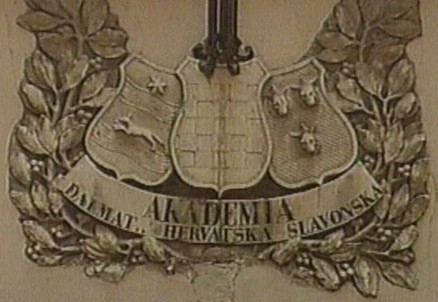
Akademia Dalmatinska,
Hervatska, Slavonska in Zagreb, 1669.
Croatian
Coat of Arms above the main
entrance of the former
Jesuit gymnasium in Zagreb, founded in 1607 (today Gornjogradska
gimnazija in the Upper Town of Zagreb) .
Leopold I., the Emperor of the Holy Roman Empire, issued a Diploma in
1669, by which the status and privileges of a university were accorded
to the Jesuit Academy in the Royal Free City of Zagreb. This represents
the beginning of the University of Zagreb.
Let us mention some of the Universities that were founded before and after the Universities of Zadar and Zagreb: Bologna 1219, Padova 1220, Paris 1220, Oxford 1249, Lisabon 1290, Rome 1303, Cambridge 1318, Florence 1321, Prague 1348, Krakow 1364, Vienna 1365, Erfurt 1379, Heidelberg 1385, ZADAR 1396, Rostock 1419, Glasgow 1453, Tübingen 1477, Uppsala 1477, Copenhagen 1479, Mainz 1494, Edinburgh 1582, Dublin 1591, Lwow 1661, ZAGREB 1669, LEPOGLAVA (1674-1782), Göttingen 1736, Erlangen 1743, Moscow 1775, Berlin 1809, Saint Petersburg 1819, London 1825, Helsinki 1826, Kiev 1834, Athens 1834, Tokyo 1881, Constantinople 1900, etc.
The Jesuit Academy was oriented mainly to theology, philosophy, law and classical philology. From 1747 there was also a chair for controversistic, aiming to study all the open questions existing between the Eastern and Western Church, conditioned obviously by the presence of Pravoslavs (Orthodox Christians) in Croatia.
The Paulines from Lepoglava near Varazdin organized a three year study of philosophy in 1656 (with lectures on logic, mathematics, physics, metaphysics and ethics) and a four year study of theology in 1683. By the rescripts of Pope Clement X in 1671 and Emperor Leopold I in 1674 it became `studium generale' with a right of conferring doctorates. The Pauline order was canceled in 1786 by a decision of Austrian archduke Joseph II. The huge building of the Lepoglava Puline Academy, which represents one of the most important monuments of sacral architecture in Croatia, was transformed into prison in 1854. It was a tremendous loss for Croatian education and culture.
During the French rule in Dalmatia (1805-1813) the Gymnasium of Zadar was transformed to Lyceum in 1806. After the Illyrian province had been founded it became a Central school with lectures on seven academic disciplines from engineering to medicine and law, having the right of conferring academic titles. So, this institution acted as a university with seven faculties, but unfortunately it was canceled in 1811.
The University in modern sense, including science and engineering, was founded in Zagreb in 1874, thanks to the efforts of the great Croatian Maecenas bishop Josip Juraj Strossmayer (born in Osijek, 1815-1905). It had three faculties: Law, Theology and Philosophy, from which soon many new faculties developed. Ivan Mazuranic, a great Croatian poet and statesman (1814-1890), was the Ban (Viceroy) and the president of the Croatian government when the University was opened.
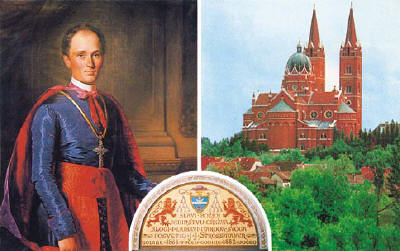
J.J.
Strossmayer became internationally known for his speech against the
dogma of papal infallibility at the Vatican synod held in 1869-70. He
was also one of the originators of the unhappy idea
of Yugoslavia,
a common state for southern Slavs to live in. He founded the Yugoslav
Academy of Sciences and Arts in Zagreb in 1866, long before Yugoslavia
was created as a state (first as the Kingdom of Serbs, Croats, Slovenes
in 1918, and then renamed to Yugoslavia in 1929). These are the oldest
scientific and educational institutions in the south-east Europe.
Additional
information about J.J.
Strossmayer.
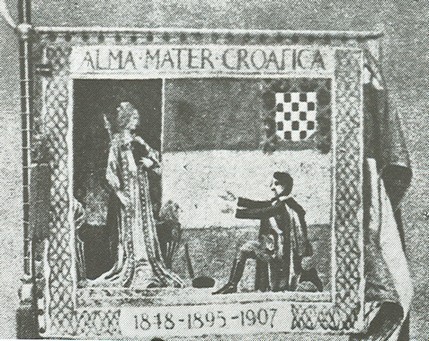
Flag of the University of Zagreb from 1907, with Croatian Coat of Arms
The Yugoslav Academy of Sciences and Arts was renamed to the Croatian Academy of Sciences and Arts (HAZU) first in 1941 and then again in 1991. It is interesting to note that in former Yugoslavia all the six republics and two Serbian autonomous provinces had their own national Academies, except Croatia, where the term `Yugoslav' was traditionally kept.
Let us mention that the first president of the Serbian Academy of Sciences and Arts, founded in 1887, was a Croat - Josip Pancic (1814-1888, a botanist, born in the Croatian town of Bribir).

The University of Zagreb today
Today our University is a huge educational and scientific organization comprising 25 faculties and colleges, some 3000 professors and teaching assistants and some 35,000 students (we had 5400 students and postgraduates in 1938). It has a rich cooperation with foreign institutions, but needs a further support in this direction. Great importance has the movement called `Alma Mater Croatica', whose wish and aim is to unite our former students, now scientists scattered about many universities and research centers on the West. `Alma Mater Croatica' is the symbolic name for the Zagreb University.
University of Zagreb (photo by D.Z., 2007)
Except in Zagreb, there are very young university centers in Osijek, Split and Rijeka. Parts of the University of Zagreb are in Varazdin and Slavonski Brod.
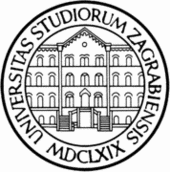
There is an army of as many as 45,000 specialists educated in Croatia, working today mostly in western countries. On one hand, it points out clearly the quality of our Universities, and on the other, the political and economic conditions in Croatia within ex Yugoslavia.
The University library, founded in 1606, has about 2,500,000 books.
A great care is devoted to the living standard of students. About 6000 students live in student dormitories and subsidized student restaurants serve about 20,000 meals daily.
University of Zagreb (photo by D.Z., 2007)
The Zagreb University had many foreign students, primarily from the developing countries.
Very rich international cooperation, initiated by prof. Ivan Supek in 1971, has been established through scientific seminars and meetings held at the Inter-university Center for Postgraduate Studies in Dubrovnik. In the aggression of Serbia and Montenegro on Croatia the Center was totally destroyed (1991). It is worth noting that this object, together with its library comprising 30,000 volumes, has been the first to be destroyed in Dubrovnik. These carefully chosen targets reveal one of the major aims of the Serbian aggression in 1991-1995. For more information see LIBROCIDE and [Wounded Libraries in Croatia]
Croatian Nobel prize winners
Ivo Andric, (studied in Zagreb) for literature, 1961. He was a Croat born in Bosnia and educated by the Bosnian Jesuits. His books reflect the interference of different cultures existing in Bosnia.
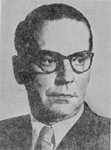
His father Antun, who died during Andric's earliest childhood, was attendant of the Jesuit gymnasium in Travnik, Bosnia, and his mother was a housewife. Ivo Andrich inscribed the same Jesuit gymnasium, and then went to the Sarajevo gymnasium where he was the stipendist of the Croatian Cultural Society Napredak (which means "progress", Croatian cultural society in Bosia and Herzegovina).
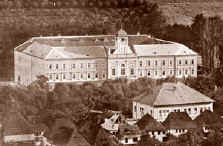
Then he attended the Faculty of philosophy in Zagreb, Croatian capital. In 1919, after his studies in Zagreb, he moved to Belgrade, where he started his career as a diplomat, working in Rome, Bucharest, Trieste, Graz (where he defended his thesis), Marseille, Paris, Madrid, Bruxelles, Geneve, and finally occupied the position of ambassador of the very young Yugoslav state in Berlin (1939-1941).
 During
his studies at the University of Krakow, Poland, Ivo Andric filled in
his matriculation form as follows:
During
his studies at the University of Krakow, Poland, Ivo Andric filled in
his matriculation form as follows:
- religion - Roman Catholic (Religia Kat.),
- nationality - Croatian (Narodowosc Chorwat).
Habent sua fata libelli.
Lavoslav Ruzicka (1887-1976, born in Vukovar, of a Czech father and a Croat mother, attended the gymnasium of Osijek), for discoveries in organic chemistry, professor at the Technische Hochschule in Zurich, Switzerland 1939; see Ruzicka links.
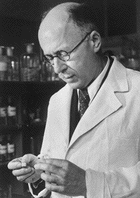
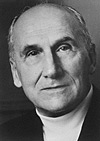
![]()
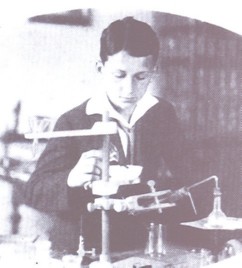
It is interesting to mention that Nikola Tesla refused to receive the Nobel prize for physics, which he had to share with T.A. Edison.
The name of Mother Teresa (1910-1997, Albanian, born in Skopje in Macedonia), Nobel prize winner for peace 1979, cannot be avoided. The Croatian Jesuits had a great role in her spiritual development. Indeed, Fr. Franjo Jambrekovic, a Croatian Jesuit and parish priest at Skopje, had a profound influence on Mother Teresa during her childhood. As her spiritual Father, he fostered her vocation in 1928. She continued to carry on correspondence with him when she lived in India. She also nurtured a deep friendship with Fr. Ante Gabric in India, and talked to him in Croatian.
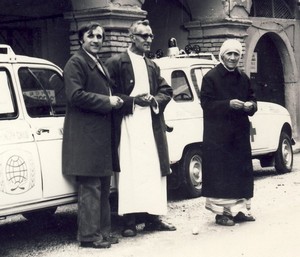
Mother Teresa in Zagreb in 1977 with Fr. Ante Gabric and Vladimir Palecek on the left. Many thanks to Snjezana Bozic for the photo.
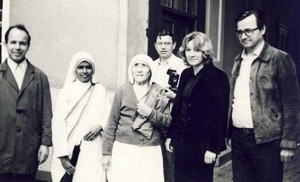
Mother Teresa in Zagreb in the court of Basilica of Sacred Heart of Jesus, Palmoticeva 31, around 1980. Many thanks to Br. Ivo Domazet (on the photo on the left).
The city of Zagreb, where much later Mother Teresa opened a house (in 1979), was one of the steps on her road to India. She visited the city of Zagreb and Croatia on many occasions, and always spoke Croatian. Moreover, once she even delivered a sermon in the Zagreb cathedral in Croatian. On that occasion she praised Medjugorje. It is also important to add that Mother Teresa obtained honorary Croatian citizenship in 1990.
The first monument in the world honouring Mother Teresa was carved in Supetar on the island of Brac (2002). It was unveiled by Martin Sheen.
After many years she met her brother who lived in Italy, who forgot his native Albanian (and did not speak English). Surprisingly, they were able to communicate only in Croatian! Her letters written in Croatian to her colleagues in Zagreb are kept in the Zagreb Archbishopric. Also, her prayers (Lord's Prayer, Hail Mary, etc.) pronounced in Croatian were recorded during one of her stays in Croatia. They can be heard from time to time broadcast on Radio Marija.
Back to Croatia - an overview of its History, Culture and Science
